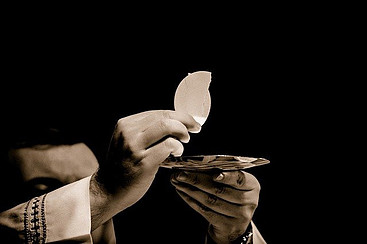A 17th-century marble inscription describes the Eucharistic Miracle of Lanciano in Italy that took place in the church of San Francesco in 750. “The monastery priest questioned the actual presence of our Lord in the consecrated host. He celebrated Mass, and when he pronounced the consecration, he saw that the host had turned to flesh and wine to blood. All this happened before the eyes of the gathered believers. The meat has been preserved to this day, and the blood has been divided into five unequal parts, which together weigh the same as each one. ”
Dr. Odoardo Linoli Researched in Detail This Famous Eucharistic Miracle of Lanciano in Italy

In 1970, the Archbishop of Lanciano and the Provincial Minister of the Franciscan Monks in the Province of Abruzzo, with the consent of Rome, asked Dr. Odoardo Linoli, director of the Arezzo Hospital and professor of anatomy, histology, chemistry, and clinical microscopy, to conduct a thorough scientific examination of the relics of the miracle that took place twelve centuries ago.
The professor presented a report on the various tests he had taken on 4 March 1971. He noted the following:
- “Miracle meat” is real meat consisting of transversely striated heart muscle tissue.
- “Miracle blood” is real blood. This is clearly and unequivocally confirmed by chromatographic analysis.
- An immunological study has unequivocally shown that meat and blood are human, and an immuno-hematological examination has confirmed completely objectively and unequivocally that they both belong to the same blood type, AB. This type of blood is also the blood type of a man wrapped in a Turin tablecloth and is most characteristic among the population of the Middle East.
- Proteins in the blood are normally distributed in the same percentage as in the serum protein picture of normally fresh blood.
- Histological examinations did not reveal any traces of the intrusion of salts or preservatives used for embalming in antiquity.
Blood and Flesh Are Undoubtedly of Human Origin
The flesh consists of a part of the heart muscle, more precisely of the left ventricular muscle. The arteries and veins and the split, thin vagus nerve are clearly visible. At the time of the miracle, the flesh was alive, but then it was ruled by the laws of mortal obstinacy.
Five blood clots under a magnifying glass. In the miracle blood, we can identify all the components present in fresh blood, and an additional miracle is that each of these blood clots weighs 15.85 grams, the same as all five clots combined!
Relics of this miracle are today stored in precious silver and crystal artistically made monstrances from the 18th century in the church of St. Francis. Behind the upper glass part of the monstrance, which has a diameter of 69 mm, you can see the host that has become and remains meat. In a covered glass goblet, 10 cm in diameter, are five lumps of clotted blood on the underside of the monstrance.
The Question Arises as to Whether This and Other Similar Cases Are the Actual Flesh and Blood of Jesus
Let us first consider the consecrated host. Theology teaches that the essence (substance) of bread, which is not perceptible to the senses, is transformed into the body of Jesus in the priest’s consecration words; images or accents, that is, the external properties of bread, remain as they were before. After the consecration, the holy host is just as white and heavy, of the same taste and nutritional value, and as round as before. Images are not the body of Jesus; they are not Jesus. Jesus is present in the consecrated host in a glorified state, just as the soul is present in our body. It is all in the holy host and every part of it.
Jesus Introduces Himself Under Images of Blood and Flesh
In the Eucharistic miracle, in which the consecrated holy host is transformed into human flesh and (or) the consecrated wine is transformed into human blood, only the images of bread and wine are changed in the image of flesh and blood. Jesus himself, however, remains present under these new images. Flesh and blood, therefore, play the role of Eucharistic images. All of Jesus is present in every particle of flesh and blood. Thus, in the Eucharistic miracles, under the image of the flesh, we worship and pray to Jesus himself, and also under the image of blood. Therefore, we believe that in Lancian, Jesus is present night and day for 1260 years under images of flesh and blood. Isn’t that something extraordinary? The priest in the Tabernacle often changes the host and consecrates at least one host at each Mass. So it is always a new presence. In Lanciano, however, the presence lasts as it lasts in heaven, although we still accept it by faith, and in heaven, we will see Jesus face to face (1 Cor 13:12).
Flesh and blood, which, by the miraculous work of God, arise from the consecrated host, are, therefore, not part of the body and blood of Jesus. But flesh and blood in the miracle clearly show that in the change, the bread and wine really become the body and blood of Christ, Christ himself.